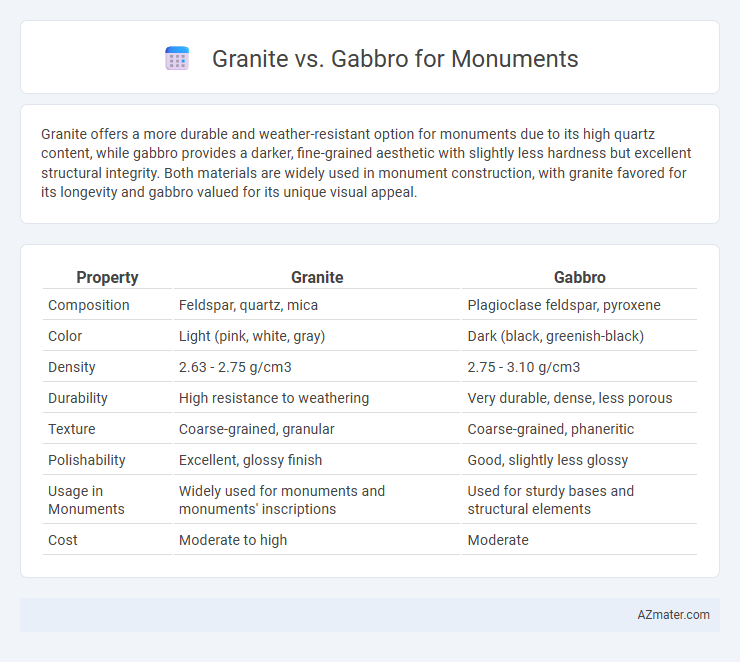Granite offers a more durable and weather-resistant option for monuments due to its high quartz content, while gabbro provides a darker, fine-grained aesthetic with slightly less hardness but excellent structural integrity. Both materials are widely used in monument construction, with granite favored for its longevity and gabbro valued for its unique visual appeal.
Table of Comparison
| Property | Granite | Gabbro |
|---|---|---|
| Composition | Feldspar, quartz, mica | Plagioclase feldspar, pyroxene |
| Color | Light (pink, white, gray) | Dark (black, greenish-black) |
| Density | 2.63 - 2.75 g/cm3 | 2.75 - 3.10 g/cm3 |
| Durability | High resistance to weathering | Very durable, dense, less porous |
| Texture | Coarse-grained, granular | Coarse-grained, phaneritic |
| Polishability | Excellent, glossy finish | Good, slightly less glossy |
| Usage in Monuments | Widely used for monuments and monuments' inscriptions | Used for sturdy bases and structural elements |
| Cost | Moderate to high | Moderate |
Introduction to Granite and Gabbro
Granite and gabbro are both igneous rocks commonly used in monuments due to their durability and aesthetic appeal. Granite is a coarse-grained rock composed mainly of quartz, feldspar, and mica, known for its light color variations and high resistance to weathering. Gabbro, darker and denser than granite, consists primarily of plagioclase feldspar and pyroxene, offering a unique color palette and strong structural integrity for long-lasting memorials.
Geological Origins of Granite and Gabbro
Granite forms from the slow crystallization of magma beneath the Earth's surface, composed mainly of quartz, feldspar, and mica, resulting in a coarse-grained texture. Gabbro originates from the slow cooling of mafic magma deep within the Earth, characterized by a dark, dense composition rich in pyroxene and calcium-rich plagioclase. Both igneous rocks are intrusive, but their differing mineral compositions and formation depths influence their suitability and appearance for monumental use.
Appearance and Color Differences
Granite exhibits a lighter, speckled appearance with visible grains of quartz, feldspar, and mica, creating a more varied and colorful pattern ideal for monuments requiring a bright, polished finish. Gabbro, in contrast, features a darker, more uniform color palette dominated by black and dark green minerals like pyroxene and plagioclase, offering a sleek, solid look preferred for somber or modern monument designs. The distinct mineral compositions directly influence the texture and hue, making granite more vibrant and gabbro more subdued in monument applications.
Durability and Weather Resistance
Granite and gabbro are both igneous rocks commonly used for monuments due to their excellent durability and weather resistance. Granite, composed mainly of quartz and feldspar, offers superior hardness and resistance to abrasion, making it ideal for enduring harsh weather conditions and environmental wear over centuries. Gabbro, characterized by its dense, coarse-grained texture rich in pyroxene and plagioclase, also provides strong weather resistance but may be slightly less durable than granite when exposed to freeze-thaw cycles and acidic rain.
Workability and Sculpting Challenges
Granite offers superior workability for monuments due to its consistent grain size and relative hardness of 6-7 on the Mohs scale, enabling detailed sculpting and fine finishes. Gabbro, while durable with a similar hardness, presents challenges because of its coarser texture and denser mineral composition, often requiring specialized tools and techniques for precise carving. Sculptors favor granite for intricate designs, whereas gabbro is chosen for more robust, simplified forms where durability outweighs detailed aesthetic work.
Cost Comparison for Monument Projects
Granite typically costs more than gabbro for monument projects due to its higher density, durability, and widespread demand in construction and memorial industry, with prices ranging from $40 to $100 per square foot compared to gabbro's $30 to $70 per square foot. Gabbro offers a cost-effective alternative with comparable durability and a unique dark appearance but may require more maintenance in harsh weather environments. Budget-conscious monument projects often favor gabbro for its affordability while premium monuments prioritize granite for its prestige and longevity.
Maintenance and Longevity
Granite and gabbro are both durable igneous rocks commonly used for monuments, with granite offering superior resistance to weathering and staining due to its high quartz content, which contributes to lower maintenance requirements. Gabbro, while also hard and dense, is more prone to surface wear and may require more frequent sealing to preserve its appearance over time. Longevity for granite monuments typically exceeds several decades with minimal upkeep, whereas gabbro monuments may demand more consistent care to maintain their structural integrity and visual appeal.
Historical and Modern Monument Usage
Granite and gabbro have been extensively used in historical and modern monuments due to their durability and aesthetic appeal. Granite, with its coarse-grained texture and wide range of colors, has been a preferred choice for iconic structures such as the Mount Rushmore National Memorial and ancient Egyptian obelisks. Gabbro, characterized by its dark coloration and fine grain, is utilized in contemporary monuments and sculptures for its strength and sleek appearance, complementing modern architectural designs.
Cultural Significance and Aesthetic Appeal
Granite and Gabbro both hold cultural significance in monument construction, with granite historically favored for its durability and association with prestige in ancient civilizations such as Egypt and Rome. Granite's wide range of colors, grain patterns, and polished finish enhance its aesthetic appeal, making it a popular choice for sculptural details and memorials. Gabbro, darker and denser with a coarse-grained texture, offers a unique aesthetic often appreciated for its deep black or greenish hues, symbolizing strength and permanence in various cultural monuments worldwide.
Choosing the Right Stone for Your Monument
Granite and gabbro are both durable igneous rocks commonly used for monuments, but granite offers greater color variety and finer grain, making it ideal for detailed engraving and aesthetic appeal. Gabbro, with its darker, more uniform appearance and high resistance to weathering, is preferred for bold, minimalist monuments that require long-lasting strength. Selecting the right stone depends on desired visual impact, durability needs, and the monument's environmental exposure.

Infographic: Granite vs Gabbro for Monument
 azmater.com
azmater.com